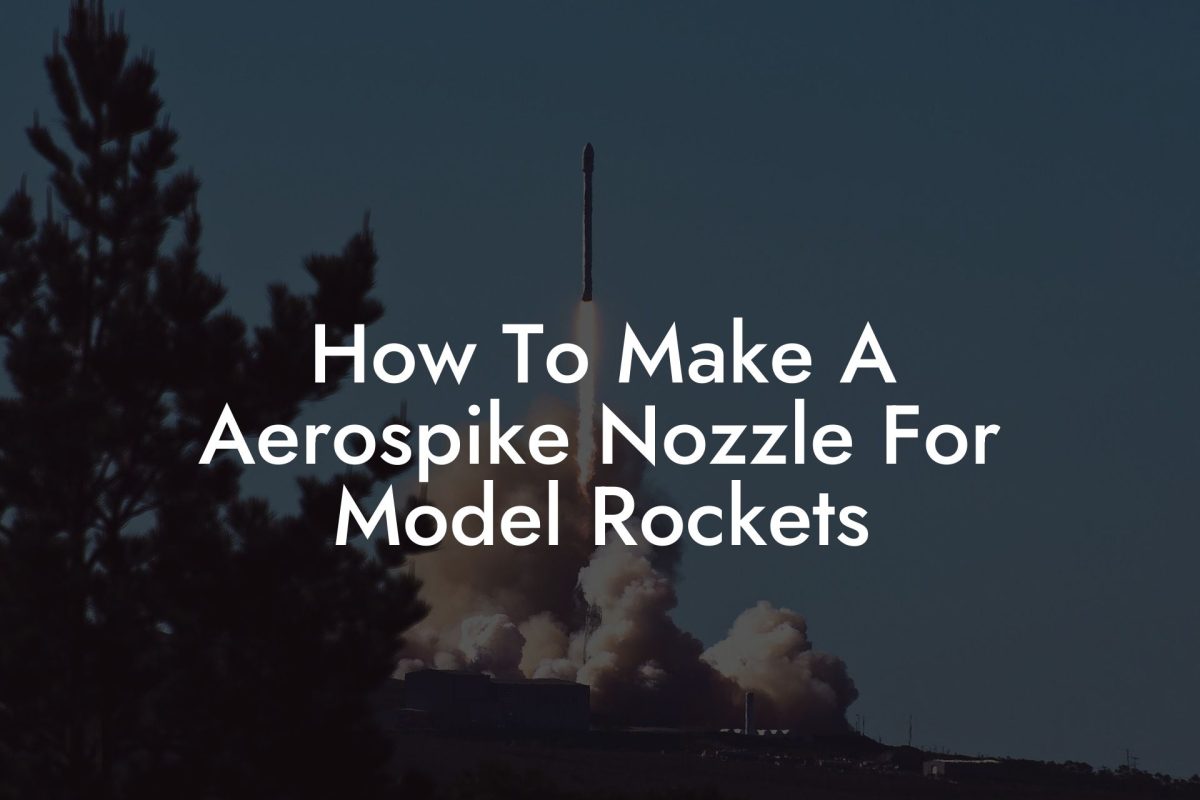Imagine a world where model rockets soar into the sky, defying gravity and captivating the imagination of enthusiasts of all ages. Welcome to the realm of large F engine model rockets, where the thrill of flight meets the art of precision engineering. In this comprehensive guide, we'll delve into the world of large F engine model rockets, exploring the technology, techniques, and community that drive this fascinating hobby.
Quick Links to Useful Sections
- What Are Large F Engine Model Rockets?
- The Anatomy of a Large F Engine model rocket
- Designing and Building a Large F Engine model rocket
- Stability and Aerodynamics
- Motor Selection and Integration
- Recovery System Design
- Launching and Flying a Large F Engine Model Rocket
- Pre-launch Checks
- Launch Site Selection
- Launch and Recovery
- Large F Engine Model Rocket Safety Considerations
- Eye and Ear Protection
- Launch Site Safety
- Motor Handling and Storage
- Large F Engine Model Rocket Community and Resources
- Online Forums and Groups
- Local Clubs and Meetups
- Manufacturer Resources
- Frequently Asked Questions: Large F Engine Model Rockets
- Resources and Community Support: Your Next Steps
- Join Online Forums and Groups
- Find Local Clubs and Meetups
- Explore Manufacturer Resources
What Are Large F Engine Model Rockets?
Large F engine model rockets are a class of high-powered rockets that use F-sized motors to propel them into the sky. These motors are designed to produce a significant amount of thrust, typically in the range of 80-120 Newton-seconds. This power enables model rockets to reach incredible heights, often exceeding 1,000 feet, and achieve speeds of over 200 mph.
The "F" designation refers to the motor's impulse class, which is a measure of the total thrust produced by the motor over its burn time. F motors are considered mid-range in terms of power, falling between the smaller E motors and the larger G motors.
The Anatomy of a Large F Engine model rocket
A large F engine model rocket typically consists of several key components:
- Nose Cone: The pointed tip of the rocket, designed to reduce air resistance and protect the payload during ascent.
- Body Tube: The main structure of the rocket, which houses the motor, recovery system, and payload.
- Motor Mount: A specialized component that secures the F motor in place and provides a stable platform for ignition.
- Recovery System: A parachute or other device that deploys after apogee, slowing the rocket's descent and ensuring a safe landing.
- Payload: The cargo carried by the rocket, which can include cameras, sensors, or other instruments.
Designing and Building a Large F Engine model rocket
Building a large F engine model rocket requires careful planning, precision engineering, and attention to detail. Here are some key considerations:
Looking For The Best Model Rocket Kits? You'll Love These:
Stability and Aerodynamics
The rocket's shape and design must be optimized for stability and aerodynamics, ensuring a smooth and predictable flight path.
Motor Selection and Integration
The F motor must be carefully selected and integrated into the rocket's design, taking into account factors such as thrust, burn time, and stability.
Recovery System Design
The recovery system must be designed to deploy reliably and slow the rocket's descent, ensuring a safe and controlled landing.
Launching and Flying a Large F Engine Model Rocket
Launching a large F engine model rocket requires a safe and controlled environment, as well as careful preparation and planning:
Pre-launch Checks
Before launch, the rocket must be thoroughly inspected and checked to ensure all systems are functioning properly.
Launch Site Selection
The launch site must be carefully selected to ensure a safe and clear flight path, with adequate space for recovery.
Launch and Recovery
The rocket is launched, and the recovery system deploys after apogee, slowing the rocket's descent and ensuring a safe landing.
Large F Engine Model Rocket Safety Considerations
Safety is paramount when working with large F engine model rockets. Here are some key considerations:
Eye and Ear Protection
Always wear protective eyewear and ear protection when launching and recovering model rockets.
Launch Site Safety
Ensure the launch site is clear of obstacles and bystanders, and that the rocket is launched at a safe angle.
Motor Handling and Storage
Handle F motors with care, following proper storage and handling procedures to prevent accidents.
Large F Engine Model Rocket Community and Resources
The large F engine model rocket community is active and vibrant, with numerous resources available for enthusiasts:
Online Forums and Groups
Join online forums and groups to connect with other enthusiasts, share knowledge, and learn from experts.
Local Clubs and Meetups
Find local clubs and meetups to connect with other enthusiasts and participate in launches and events.
Manufacturer Resources
Take advantage of resources provided by manufacturers, including tutorials, documentation, and customer support.
Frequently Asked Questions: Large F Engine Model Rockets
Here are some frequently asked questions about large F engine model rockets:
1. What is the largest F motor available?
The largest F motor available is typically the F167, which produces 167 Newton-seconds of thrust.
2. How high can a large F engine model rocket fly?
Large F engine model rockets can reach heights of over 1,000 feet, depending on the motor and design.
3. Are large F engine model rockets safe?
When handled and launched properly, large F engine model rockets are safe. However, they do require careful attention to safety protocols and precautions.
Resources and Community Support: Your Next Steps
Now that you've explored the world of large F engine model rockets, it's time to take the next step:
Join Online Forums and Groups
Connect with other enthusiasts and learn from experts in the field.
Find Local Clubs and Meetups
Participate in launches and events, and connect with other enthusiasts in your area.
Explore Manufacturer Resources
Take advantage of tutorials, documentation, and customer support from manufacturers.
Embark on your journey into the world of large F engine model rockets, and discover the thrill of flight and the art of precision engineering.
Looking For The Best Model Rocket Kits? You'll Love These:
Useful Interruption: Dive deeper into the world of Model Rockets with our most popular sections. If there is anything you think is missing or anything you would love for us to write about, just give us a shout.
- Getting Started & Basics With Model Rockets
- Model Rocket Design, Build & Customization
- Model Rocket Propulsion & Engine Technology
- Model Rocket Launch Techniques & Recovery
- Model Rocket Advanced Rocketry & Innovations
- Model Rocket DIY and Customization
- Model Rocket Equipment Reviews & Digital Tools
- Community, Competitions & Education
- Model Rocket Troubleshooting & FAQs
- Model Rocket Bonus/Seasonal & Niche Topics
A group of model rocket enthusiasts gathered at a field for their weekly launch event. Among them was Dave, a seasoned builder known for pushing the limits of hobby rocketry. This time, he had outdone himself.
“Ladies and gentlemen,” Dave announced, dramatically pulling a cloth off his latest creation, “I present to you: The Kraken!”
The crowd gasped. This wasn’t just a model rocket—it was a monster. The thing stood 8 feet tall, had six clustered engines, and was covered in enough duct tape to qualify as a classified aerospace project.
“Dave,” muttered Steve, the cautious safety officer, “Have you, uh… done the math on this?”
“Math?” Dave scoffed. “I built it in my garage at 3 a.m. with parts from eBay. This is an art piece, Steve.”
The countdown began.
5…
4…
3…
2…
1…
The engines ignited with a BOOM, and The Kraken shot up… kind of. It immediately did a violent barrel roll, narrowly missing the spectators before skyrocketing at an angle that could only be described as “legally questionable.”
The crowd collectively ducked as The Kraken flew straight over the adjacent cornfield, where Old Man Jenkins, the grumpiest farmer in town, was minding his business.
KABOOM!
The rocket disappeared behind the barn. A moment later, a flaming piece of Estes igniter wire landed at Steve’s feet. The silence was deafening.
And then—an unmistakable sound echoed across the field.
Jenkins’ shotgun being cocked.
“DAVE!!!” Steve shouted. “RUN.”
And that was the day Dave invented the first-ever biologically powered rocket booster: pure adrenaline.
To this day, nobody knows where The Kraken landed, but legend has it, it still haunts the skies, terrifying unsuspecting drones and low-flying birds.















